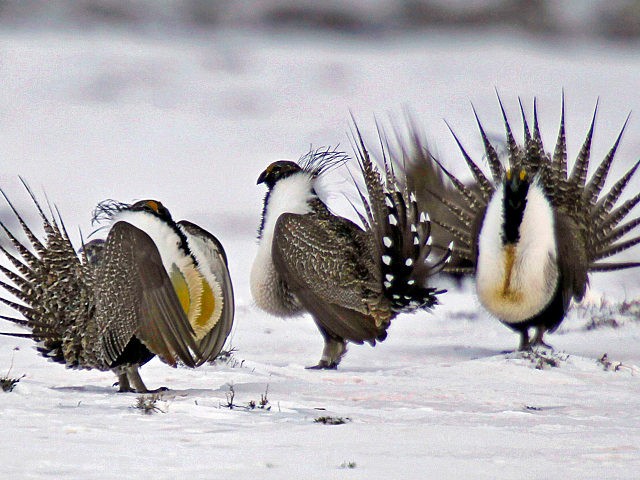The Trump administration is putting plans in place to protect the once-endangered sage grouse but also allow millions of acres to benefit Americans in the states where the birds live, including plans to allow more oil and gas drilling, mining, and other activities.
The leftist media is reporting that the move by the Department of Interior (DOI) could harm the species.
“Critics warned the changes could wipe out grouse colonies as drilling disrupts breeding grounds,” the Associated Press (AP) reported. “Federal officials under President Barack Obama in 2015 had adopted a sweeping set of land use restrictions intended to stop the birds’ decline.”
The AP story did include comments from Interior Deputy Secretary David Bernhardt, who said the birds still will be protected but in a way that also serves people.
“I completely believe that these plans are leaning forward on the conservation of sage grouse,” Bernhardt said in the AP story. ”Do they do it in exactly the same way? No. We made some change in the plans and got rid of some things that are simply not necessary.”
The plan comes partly in response to governors from states with sage grouse habitats.
“This is a great example of federal leaders listening to state leaders, valuing their expertise, and changing their plans based on that input,” Utah Gov. Gary Herbert, a Republican, said in a statement about the DOI’s announcement last week.
But critics claim the plan is to benefit the oil and gas industry, which aside from building domestic energy resources, create jobs for Americans.
“This new plan undermines the delicate balance Western states had struck to ensure the protection of sage grouse populations and strengthen economic development across the western United States,” said Sen. Catherine Cortez Masto (D-NV), adding that the Trump administration is putting “the interests of the oil and gas industry ahead of the best interests of Nevadans.”
“If you allow exception after exception, that might make sense for a particular project in a particular spot, but you add them all together and you have death by a thousand cuts,” National Wildlife Federation Vice President Tracy Stone-Manning told AP.
In 2015, the U.S. Fish and Wildlife Service under President Barack Obama said it would review the sage grouse’s status in 2020, but DOI said it would work instead with the Western Association of Fish and Wildlife Agencies to monitor the effectiveness of its conservation plan.
AP reported:
The new plans remove the most protective habitat designations for about 13,000 square miles (34,000 square kilometers) of public land. Those areas, considered essential to the species’ survival, were a centerpiece of the Obama policy. The Trump administration also wants to drop some requirements to prioritize leasing for oil and gas outside sage grouse habitat.
The Trump administration’s proposal would reverse or modify the Obama-era protections in seven states — Wyoming, Nevada, Utah, Colorado, California, Idaho and Oregon. No significant changes were proposed in Montana, Washington or the Dakotas.
“We can do both — protect sage grouse and move forward with responsible energy development,” Kathleen Sgamma of the Western Energy Alliance, which represents more than 300 oil and gas companies, said in the AP report. “We’ve reduced the size of well pads, reduced the numbers of wells. And we had done all these things and the prior administration assumed development was taking place like it was 20 years ago.”
Governors from those states and the public will be able to comment on the new plan before a final decision is made in early 2019.
“The BLM [Bureau of Land Managment] is currently working to better align its resource management plans with respective state wildlife management plans through proposed amendments that have been developed in collaboration with governors, state wildlife managers and other stakeholders,” the DOI website states.
“The BLM has published final environmental impact statements (EISs) and proposed amendments to the current plans. A 30-day period to protest proposed amendments will open on December 7, 2018, and close on January 8, 2019,” the website states.
Follow Penny Starr on Twitter.

COMMENTS
Please let us know if you're having issues with commenting.